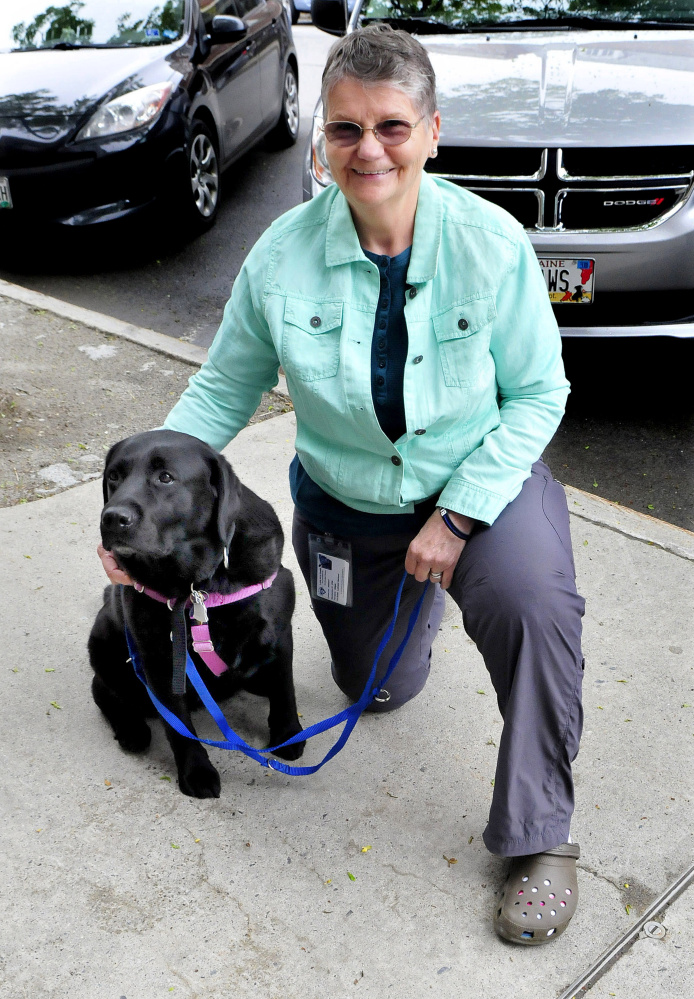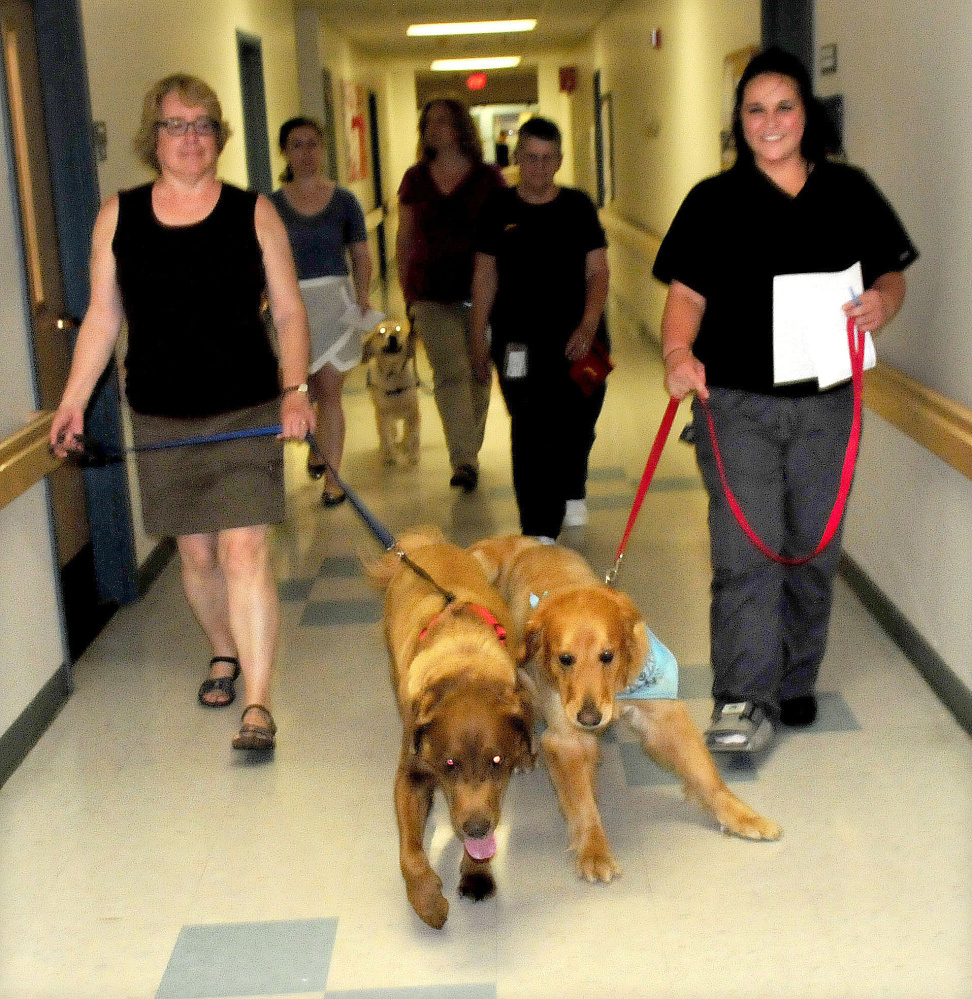Sister Dorothy Bujold always had a dog while growing up on the coast of Canada, so much so that the dogs “were practically a member of the family.”
When a group of dogs and their owners visit Mount St. Joseph Residence and Rehabilitation in Waterville, they take Bujold and other residents back in time. They also provide a source of joy to the patients and residents staying there.
“I think, you know, they can understand us,” said Bujold, who lives on one floor of a residence reserved for the Sisters of St. Joseph of Lyon. “The dog says many words without speaking.” Bujold smiled as she sat and petted a golden retriever named Caroline. The 7-year-old dog gently put her paws on Bujold’s lap so Bujold could reach her more easily.
Some people “cannot stand it” when the dogs leave, Bujold said. When two other sisters see the group of four women and three dogs move down the hallway toward a recreation room, they quickly take off after them with their walkers, eager for more opportunity to coo over the animals.
The popularity of pet and dog therapy programs is increasing, according to a number of sources, but it has been difficult for some programs to recruit enough volunteers to meet the rising demand.
The Kennebec Valley chapter of Love on a Leash, a nationwide nonprofit that provides a framework and certification for volunteers, has nine active members, four of whom are still in orientation and not officially certified. The chapter provides dog therapy to the residents at Mount St. Joseph, but it also travels to places such as Colby College, Waterville Public Library, the Augusta Center for Health and Rehabilitation, and the Children’s Center in Augusta, according to Kate Ward, a founding chapter member who organizes the site visits.
Another three sites have asked the group to provide therapy dog visits, but Ward said they’ve had to put them on a waiting list.
“I think the only thing that’s challenging is it would be nice to have more people involved,” she said. “We don’t have enough people to meet the visits that we have scheduled.”
It’s a challenge to get people to sign up and commit to volunteering, Ward said, and people often contact her but don’t follow through. However, once people do commit and go on the first visit, they don’t stop.
BOOTMOBILE DOG
One of the new members in the Kennebec Valley Love on a Leash chapter (Maine has two this one and one Down East) is Keith Smith, the Bootmobile marketing specialist for L.L. Bean.
Smith and his wife, Terri, both work for L.L. Bean and own a 5-year-old yellow Labrador retriever named Millie, who has her own Instagram account. Millie already works as a brand ambassador and “Bootmobile marketing K-9” for the outdoors company, and Smith felt that therapy training was the logical next step so she could accompany him more often on tours around the state in the iconic Bootmobile.
Millie needs to make three more visits before she’s certified, Smith said in an email.
“It’s really powerful to see the instant connection and therapeutic value that these dogs bring to people,” he said.
Even in San Diego, home of the Love on a Leash national headquarters, organizers run into the problem of a lack of volunteers.
“We get more requests for visits than we can accommodate,” said Debbie LaChusa, a board member of the nonprofit and a volunteer for the San Diego chapter, in an email. LaChusa’s chapter makes more than 100 visits each month.
LaChusa couldn’t point to an exact reason for the slow rise in volunteers, but the required training and the certification process are potential barriers, she said.
While there has been research on the benefits of pet and dog therapy, there haven’t been any large studies on the rise in its popularity.
Deborah Linder, a research assistant professor at the Cummings School of Veterinary Medicine at the Tufts Institute for Human-Animal Interaction, said that while she doesn’t have data to point to, they “anecdotally and personally have seen an increase in requests over the past few years.”
Karen Anctil, another founding member of the Kennebec Valley group who helps Ward organize visits, agreed that there is a strong desire for the service in the central Maine area, but because most of the volunteers work full time, it’s difficult to coordinate additional visits.
“We would love to go on more visits and share (with) more people, but we just don’t have the people to do it,” she said.
THE THERAPEUTIC EFFECT
In 2011, Ward and Anctil started the local chapter of Love on a Leash, which had more than 2,000 members working in teams across the country in 2015.
Ward spends about 25 hours each month organizing visits for the group, in addition to her job as a nurse, because she enjoys it, she said.
“It’s such a great response you get when you go into the rooms and you go into the facilities,” she said. “Sometimes we’re the only visitors that people get for a week. It’s important for them, and it doesn’t take that much of my time.”
Ward decided to train her dog, Caroline, to provide therapy after Rita Pirrotta, a dog trainer who had been working with Caroline, suggested it.
As a nurse, Ward had seen the responses of people when dogs visited the hospital. The physical contact with an animal was often important, she said, especially for those who were sick and couldn’t see their own dogs anymore.
According to Linder, studies have shown both physical and mental health improvements from interacting with a therapy animal.
“From the physical health side, simply interacting with a therapy animal can improve blood pressure and reduce anxiety. One study even remarkably showed a decrease in pain perception among those visited by a therapy animal,” Linder said.
While more research is needed, she said, some studies show that there is a physical change in a person’s brain after he or she spends time with a therapy animal.
A 2005 study found that cortisol, a stress hormone, decreased after just five minutes of interaction with a therapy dog, Linder said.
Other research has shown that interaction with animals helps seniors struggling with dementia by decreasing their agitation levels and increasing their sociability.
Jamie Wood, director of life enrichment at Mount St. Joseph, said she often takes the dogs into the Alzheimer’s units.
“It’s really therapeutic for people with memory loss and dementia” because it brings back memories of when they had pets, Wood said.
Not every dog can do this kind of work, but with enough practice, most can, said Pirrotta, a dog trainer and member of the Kennebec Valley Love on a Leash chapter. “You don’t have to have a perfect dog.”
Madeline St. Amour can be contacted at 861-9239 or at:
mstamour@centralmaine.com
Twitter: madelinestamour
Send questions/comments to the editors.





Success. Please wait for the page to reload. If the page does not reload within 5 seconds, please refresh the page.
Enter your email and password to access comments.
Hi, to comment on stories you must . This profile is in addition to your subscription and website login.
Already have a commenting profile? .
Invalid username/password.
Please check your email to confirm and complete your registration.
Only subscribers are eligible to post comments. Please subscribe or login first for digital access. Here’s why.
Use the form below to reset your password. When you've submitted your account email, we will send an email with a reset code.